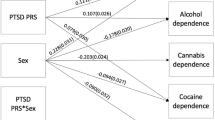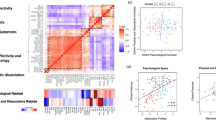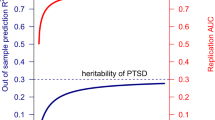Abstract
Posttraumatic stress disorder (PTSD) is a chronic anxiety disorder that follows exposure to extreme events. A large twin study of Vietnam veterans had demonstrated a significant genetic contribution to chronic PTSD upon exposure to combat.1,2 The underlying genes, however, have not been described. Given previous findings of abnormal dopamine (DA) function in PTSD, and given the putative effect of dopamine neurotransmission in shaping the responses to stress in animals, this study examined the association of the dopamine transporter (DAT) SLC6A3 3′ variable number tandem repeat (VNTR) polymorphism with PTSD. The study evaluated 102 chronic PTSD patients and 104 carefully-documented trauma survivors (TS) who did not develop PTSD. Significant excess of 9 repeat allele was observed among PTSD patients (43% vs 30.5% in TS controls; χ2 = 6.3, df = 1, P = 0.012). An excess of 9 repeat homozygous genotype was also observed in PTSD (20.43% in PTSD vs 9.47% in TS controls; χ2 = 6.11, df = 2, P < 0.047). These findings suggest that genetically determined changes in dopaminergic reactivity may contribute to the occurrence of PTSD among trauma survivors.
This is a preview of subscription content, access via your institution
Access options
Subscribe to this journal
Receive 12 print issues and online access
$259.00 per year
only $21.58 per issue
Buy this article
- Purchase on Springer Link
- Instant access to full article PDF
Prices may be subject to local taxes which are calculated during checkout
Similar content being viewed by others
References
True WR, Rice J, Eisen SA, Heath AC, Goldberg J, Lyons MJ, Nowak J . A twin study of genetic and environmental contributions to liability for posttraumatic stress symptoms Arch Gen Psychiatry 1993; 50: 257–264
Xian H, Chantarujikapong SI, Scherrer JF, Eisen SA, Lyons MJ, Goldberg J et al. Genetic and environmental influences on PTSD, alcohol and drug dependence in twin pairs Drug Alc Depend 2000; 61: 95–102
Brewin CR, Andrews B, Valentine JD . Meta analysis of risk factors for posttraumatic stress disorder J Consult Clin Psychol 2000; 68: 766–784
Yehuda R, McFarlane AC . Conflict between current knowledge about posttraumatic stress disorder and its original conceptual basis Am J Psychiatry 1995; 152: 1705–1713
Shalev AY, Pitman RK, Orr SP, Peri T, Brandes D . Auditory startle in trauma survivors with PTSD: a prospective study Am J Psychiatry 2000; 157: 255–261
Connor KM, Davidson JRT . Familial risk factors in PTSD Ann NY Acad Sci 1997; 821: 35–51
Comings DE, Muhleman D, Gysin R . Dopamine D2 receptor (DRD2) gene and susceptibility to posttraumatic stress disorder: a study and replication Biol Psychiatry 1996; 40: 368–372
Gelernter J, Southwick S, Goodson S, Morgan A, Nagy L, Charney DS . No association between D2 dopamine receptor (DRD2) ‘A’ system alleles, or DRD2 haplotypes, and posttraumatic stress disorder Biol Psychiatry 1999; 45: 620–625
Yehuda R, Southwick S, Giller EL, Ma X, Mason JW . Urinary catecholamine excretion and severity of PTSD symptoms in Vietnam combat veterans J Nerv Ment Dis 1992; 180: 321–325
Lemieux AM, Coe CL . Abuse related PTSD: evidence for chronic neuroendocrine activation in women Psychosom Med 1995; 57: 105–115
Spivak B, Vered Y, Graff E, Blum I, Mester R, Weizman A . Low platelet–poor plasma concentrations of serotonin in patients with combat related PTSD Biol Psychiatry 1999; 45: 840–845
De Bellis MD, Baum AS, Birmaher B, Keshavan MS, Eccard CH, Boring AM et al. Bennett Research Award. Developmental traumatology. Part I: Biological stress systems Biol Psychiatry 1999; 45: 1259–1270
Hamner MB, Diamond BI . Elevated plasma dopamine in posttraumatic stress disorder: a preliminary report Biol Psychiatry 1993; 33: 304–306
Inglis FM, Moghaddam B . Dopaminergic innervation of the amygdala is highly responsive to stress J Neurochem 1999; 72: 1088–1094
Goldstien LE, Rasmusson AM, Bunney BS, Roth RH . Role of the amygdala in the coordination of behavioral neuroendocrine and prefrontal cortical monoamine responses to psychological stress in the rat J Neurosci 1996; 16: 4787–4798
Puglisi-Allegra S, Cabib S . Psychopharmacology of dopamine: the contribution of comparative studies in inbred strains of mice Prog Neurobiol 1997; 51: 637–661
Cabib S, Oliverio A, Ventura R, Lucchese F, Puglisi-Allegra S . Brain dopamine receptor plasticity: testing a diathesis-stress hypothesis in an animal model Psychopharmacology 1997; 132: 153–160
Post RM, Weiss SRB, Li H, Leverich GS, Pert A . Sensitization components of PTSD: implications for therapeutics Semin Clin Neuropsychiatry 1999; 4: 282–294
Vandenbergh DJ, Persico AM, Hawkins AL, Griffin CA, Li X, Jabs EW, Uhl GR . Human dopamine transporter gene (DAT1) maps to chromosome 5p15.3 and displays a VNTR Genomics 1992; 14: 1104–1106
Cook EH, Stein MA, Krasowski MD, Cox NJ, Olkon DM, Kieffer JE, Leventhal BL . Association of attention-deficit disorder and the dopamine transporter gene Am J Hum Genet 1995; 56: 993–998
Sabol SZ, Nelson ML, Fisher C, Gunzerath L, Brody CL, Hu S et al. A genetic association for cigarette smoking behavior Health Psychol 1999; 18: 7–13
Jacobsen LK, Staley JK, Zoghbi SS, Seibyl JP, Kosten TR, Innis RB, Gelernter J . Prediction of dopamine transporter binding availability by genotype: a preliminary report Am J Psychiatry 2000; 157: 1700–1703
Heinz A, Goldman D, Jones DW, Palmour R, Hommer D, Gorey JG et al. Genotype influences in vivo dopamine availability in human striatum Neuropsychopharmacology 2000; 22: 133–139
Freedman SA, Peri T, Brandes D, Shalev AY . Predictors of chronic PTSD: a prospective study Br J Psychiatry 1999; 174: 353–359
Mander A, Clayton D . Haplotype analysis in population-based association studies using Stata Stata Techn Bull 2000; 57: 5–7
Kessler RC, Sonega A, Bromet E, Hughes M, Nelson CB . Posttraumatic stress disorder in the national comorbidity survey Arch Gen Psychiatry 1995; 52: 1048–1060
Frisch A, Postilnick D, Rockah R, Michaelovsky E, Postilnick S, Birman E et al. Association of unipolar major depressive disorder with genes of the serotonergic and dopaminergic pathways Mol Psychiatry 1999; 4: 389–392
Kang AM, Palmatier MA, Kidd KK . Global variation of a 40-bp VNTR in the 3′ untranslated region of the dopamine transporter gene (SLC6A3) Biol Psychiatry 1999; 46: 151–160
Blake DD, Weathers FW, Nagy LM, Kaloupek DG, Klaminzer G, Charney DS, Keane TM . A clinician rating scale for assessing current and life time PTSD. The CAPS-I Behavior Therapist 1990; 13: 187–188
Spitzer RL, Williams JBW, Gibbon M . Structured Clinical Interview for DSM-III-R (SCID) New York State Psychiatric Institute, Biometrics Research: New York 1987
Lerer B, Macciardi F, Segman RH, Adolfsson R, Blackwood D, Blairy S et al. Variability of 5-HT2C receptor cys23ser polymorphism among European populations and vulnerability to affective disorder Mol Psychiatry 2001; 5: 579–585
Acknowledgements
This work was supported in part by grants from the Ministry of Health (Chief Scientist), and the Milton Rosenbaum Foundation (Hebrew University), to RHS and AYS.
Author information
Authors and Affiliations
Corresponding authors
Rights and permissions
About this article
Cite this article
Segman, R., Cooper-Kazaz, R., Macciardi, F. et al. Association between the dopamine transporter gene and posttraumatic stress disorder. Mol Psychiatry 7, 903–907 (2002). https://doi.org/10.1038/sj.mp.4001085
Received:
Revised:
Accepted:
Published:
Issue Date:
DOI: https://doi.org/10.1038/sj.mp.4001085
Keywords
This article is cited by
-
Ventral Tegmental Area Dysfunction and Disruption of Dopaminergic Homeostasis: Implications for Post-traumatic Stress Disorder
Molecular Neurobiology (2021)
-
Understanding the Scientific Basis of Post-traumatic Stress Disorder (PTSD): Precision Behavioral Management Overrides Stigmatization
Molecular Neurobiology (2019)
-
Case-based blended eLearning scenarios—adequate for competence development or more?
neuropsychiatrie (2019)
-
Slower Time estimation in Post-Traumatic Stress Disorder
Scientific Reports (2018)
-
Associations Between PPP1R1B Gene Polymorphisms and Anxiety Levels in the Chinese Population
Neuroscience Bulletin (2017)



